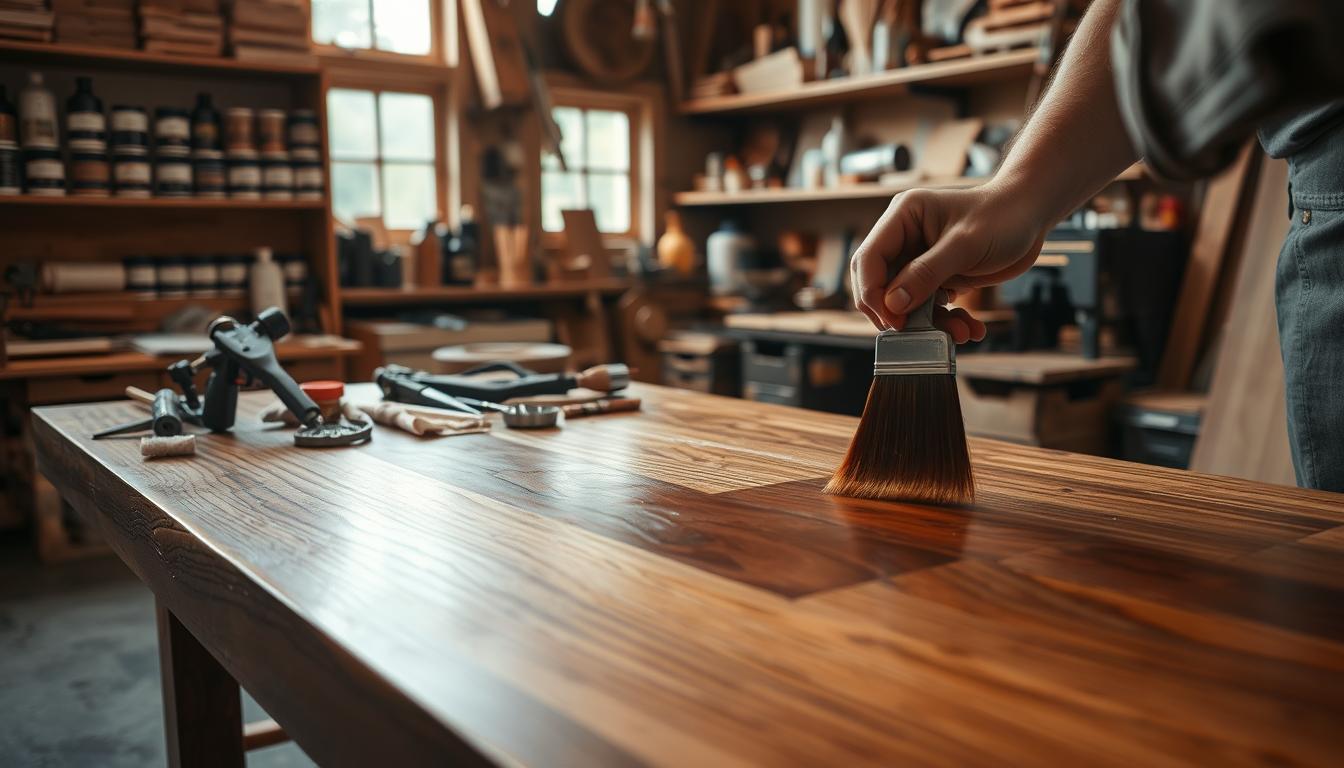Every piece of wood has a story to tell. It’s a tale of care and precision. The grain, stain, and finish show an artisan’s dedication to quality. In my workshop, I’ve spent hours learning to protect and beautify wood.
It’s not just about the wood or finish. True craftsmanship comes from preparation and application. Using different grits of sandpaper2 and choosing the right technique for each piece is crucial. Every step is part of the wood finishing art.
Table of Contents
ToggleKey Takeaways
- The choice of wood, from hardy oak to lightweight pine, influences the approach to finishing1.
- Preparatory sanding sets the foundation for a refined look2.
- Oils, varnishes, and water-based finishes accommodate different aesthetic and practical needs123.
- Application methods like brushing, wiping, and spraying adapt to the complexity and scope of the project12.
- Maintaining finished wood surfaces involves regular cleaning and appropriate polishing techniques1.
- Proper technique and patience in drying are critical to avoid common mistakes1.
- The right tools and protective gear are crucial for effective and safe wood finishing2.
>>Get 16,000 Woodworking Plans
Understanding Wood Finishing
Wood finishing is key to making wood products look great and last long. It makes the wood look better and protects it from damage. This step is very important in woodworking.
What is Wood Finishing?
Wood finishing adds a protective wood layer to the wood. It uses sealants, varnishes, stains, or lacquers. These help the wood look better and stay safe from moisture, UV rays, and scratches.
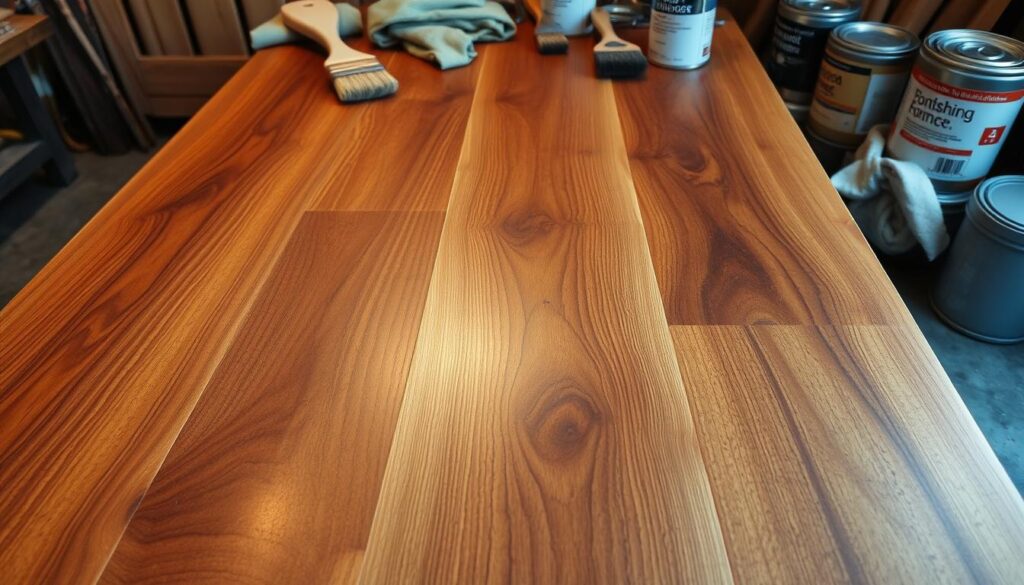
Importance of Proper Finishing
Using the right finish is crucial. It keeps the wood looking good and stable in different conditions. Finishes slow down moisture and protect against damage4.
They also make the wood less likely to warp or split. This is especially true in changing weather4.
Finishes also protect the wood from stains and scratches. They keep the wood looking new for a long time.
Common Misconceptions about Wood Finishing
Many think wood finishing is just for looks. But it also makes the wood last longer4. Choosing the right finish is important too. It depends on how the wood will be used.
For example, outdoor furniture needs finishes that protect against UV rays and moisture.
Wood finishing is an art that needs skill and care. It keeps the wood’s beauty and makes it last longer.
Types of Wood Finishing Techniques
In woodworking, the final touch makes a big difference. Knowing the unique qualities of each finish helps pick the best one for each project.
Oil-Based Finishes
Oil-based finishes, like polyurethane, give wood a warm, amber look. They’re great for woods like oak or walnut. These finishes are tough and water-resistant, perfect for items that get a lot of use wood finishing techniques. They work well with pigmented primers for durable painted finishes on wood projects7.
Water-Based Finishes
Water-based polyurethane gives a clear finish that doesn’t change the wood’s color. It dries fast and is hard, making it good for indoor projects. It’s especially good for lighter woods like birch or maple, as it prevents yellowing7.
Shellac and Lacquer
Shellac is quick-drying and natural, making wood look warm. Lacquer, on the other hand, has a glossy, durable finish. It’s great for protecting wood from damage. Both finishes highlight the wood’s beauty and protect it7.
Shellac is good for easy touch-ups and moderate protection. Lacquer is better for items that need a strong barrier against wear and tear.
>>Get 16,000 Woodworking Plans
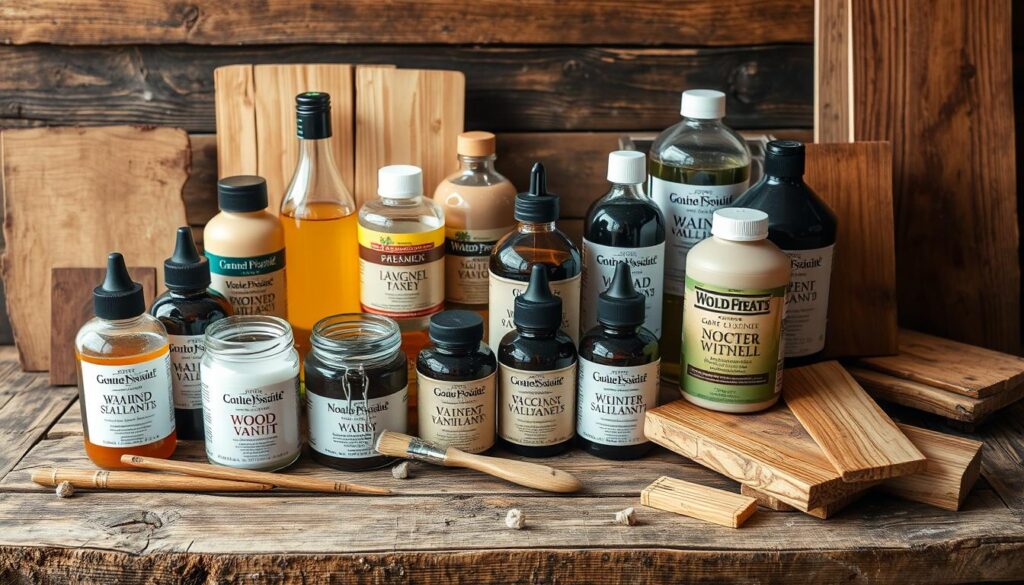
| Finish Type | Characteristic | Best Use |
|---|---|---|
| Oil-Based Polyurethane | Amber tone, durable | Floors, cabinets, furniture |
| Water-Based Polyurethane | Clear finish, quick-drying | Indoor furniture, trims |
| Shellac | Easy to repair, warm glow | Small wood crafts, fine furniture |
| Lacquer | Glossy finish, durable | High-use furniture, musical instruments |
Preparing Wood for Finishing
To get a perfect finish on wood, start with careful preparation. This step is key for a durable and beautiful finish. Let’s look at the best ways to prepare wood for amazing results.
Sanding Techniques
When Sanding Wood Surfaces, pick the right sandpaper grit. The type of wood you’re working with will tell you where to start. For example, hardwoods like oak and maple need to start with 120-grit sandpaper. Then, move to 180-grit for water-based stains9.
Cleaning the Surface
After sanding, it’s important to clean the wood well. This makes sure no dust gets in the way of the stain sticking. Use a tack cloth or a slightly damp cloth to get rid of dust. Also, clean your tools right away to keep them working well10.
Moisture Considerations
Wood moisture can affect how it looks in the end. Make sure the wood is dry before staining. Sometimes, lightly wetting the wood before sanding can make it smoother, especially with oak9.
But, let it dry completely before applying any finish. If you’re using water-based finishes, stain one section at a time. This is because these products dry quickly9.
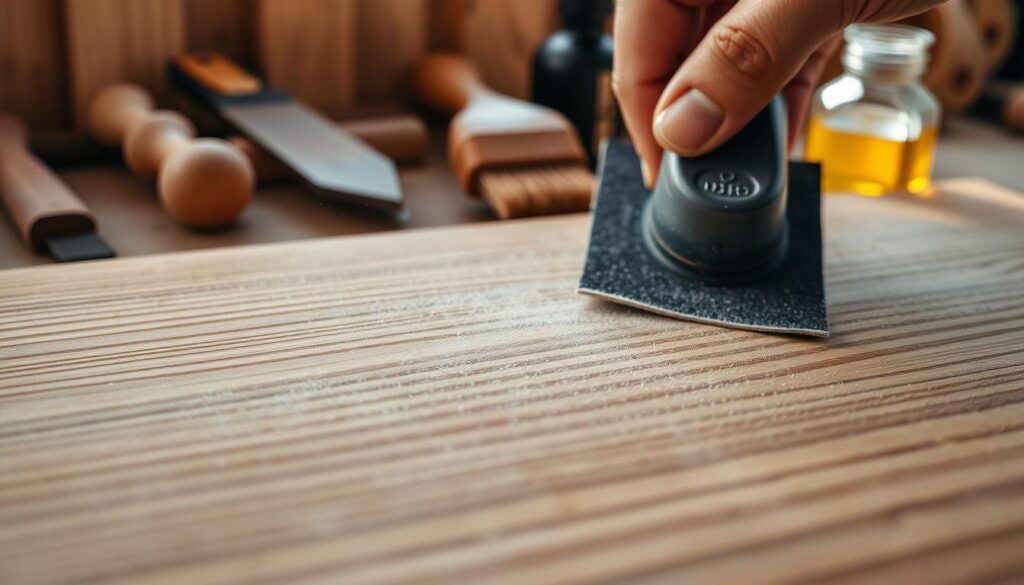
Following these steps will help you prepare wood surfaces for any finish. This ensures your work looks professional. Be thorough in your preparation to turn any wood project into a work of art.
The Finishing Process: Step-by-Step
Getting a perfect finish is key to making your wood look great and last long. It starts with careful surface prep. This includes the first coat of finish, making sure it goes on evenly for the best results. 
Applying the First Coat
Apply the first coat thinly and evenly. This helps wood stains soak in evenly, avoiding blotches.
Drying Times and Durability
Inspecting the Finish
Remember, each coat of finish not only makes the wood look better but also protects it from moisture and wear. This keeps your wood projects beautiful and strong for many years.
Staining Wood: Tips and Tricks
Working on personal projects, I’ve learned that the right stain, how you apply it, and the final touches are key. These steps not only make your wood look great but also last longer.
Choosing the Right Stain
Choosing the right stain is crucial for your project’s look and durability. The Elemental Stain Series from HB ELEMENTS has 12 shades for a unique look12. For eco-friendly options, water-based stains dry fast and have little smell13. But, oil-based stains work better on dense woods because they penetrate deeper and last longer13.
Application Methods
Blending and Touch-Ups
Blending stains can create unique colors that show off your style14. Wood aging with steel wool and vinegar adds texture and color14. For uneven absorption, touch-ups might be needed. Always finish with a protective top coat to seal and protect12.
>>Get 16,000 Woodworking Plans
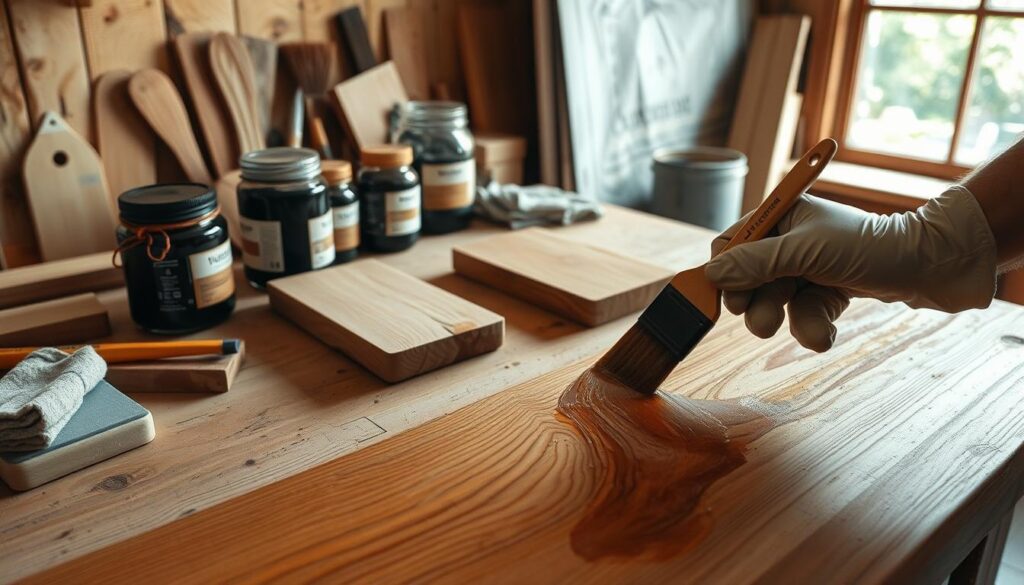
Whether you’re glazing or aging wood, the details matter. Remember, practice and patience are your best friends on this journey.
Top Coats: Sealers and Protectants
Working with wood finishing has shown me how important top coats are. They keep wood projects looking good and lasting longer. Top coats protect wood from damage and keep it looking nice.
Polyurethanes
Polyurethane wood finishes are tough and water-resistant. Water-based polyurethane gives a clear finish that doesn’t yellow over time15. It’s great for keeping wood’s natural color.
Varnishes and Oils
Choosing the Right Top Coat
Choosing the right top coat depends on the project’s needs and look you want. For furniture that gets a lot of use, polyurethane is best. For outdoor projects, use varnishes that protect against UV and mildew. For showing off wood’s grain, oils like Pure Tung Oil are good16.
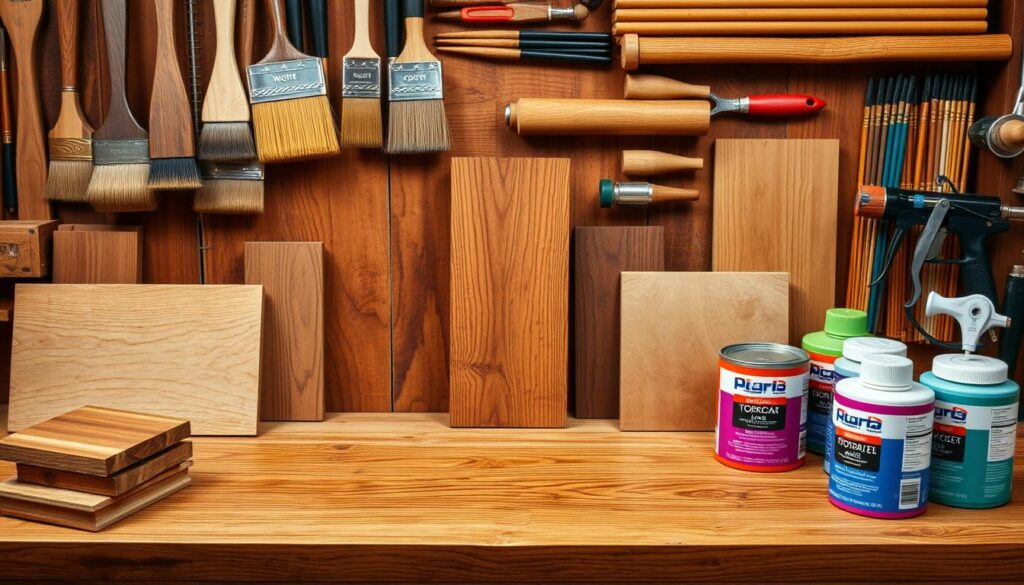
In summary, knowing about wood lacquers, painting, and finishing techniques is key. Using durable top coats makes your wood projects last longer and look better. This way, your woodworking will stay beautiful for years.
Specialty Techniques for Unique Finishes
As a woodworker, I always look for ways to improve my work. Techniques like wood painting, wood distressing, and special finishes help me create unique pieces. These methods make my work look better and meet different tastes and designs.
Below, I’ll explain some of these techniques. They can turn simple woodwork into amazing art.
Glazing for Depth
Glazing adds depth and character to wood. It involves applying a transparent or semi-transparent color layer over the paint. This highlights the wood’s features and makes it look rich and deep.
For those wanting to add depth to their wood painting, glazing is key.
Distressing Techniques
Wood distressing gives wood a worn look, perfect for rustic and vintage styles. Techniques like sanding edges or using a wire brush create this look. Chalk paint, with its matte and textured finish, is also great for this.
It’s easy to use and gives great results.
Using Chalk Paint
Chalk paint is versatile and easy to use, great for both experts and beginners. It sticks well to surfaces without needing special prep. This makes it perfect for unique finishes.
Chalk paint can be smoothed or made to look antique. You can use waxes and finishes to change its look.
In the table below, I compare traditional wood finishes with specialty finishes:
| Finishing Technique | Materials Used | Visual Appeal | Difficulty Level |
|---|---|---|---|
| Standard Wood Painting | Acrylic, Latex | Clean, Uniform | Beginner |
| Wood Distressing | Sandpaper, Wire Brush | Rustic, Aged | Intermediate |
| Glazing | Oil-based glaze | Depth Enhancing | Advanced |
| Chalk Painting | Chalk Paint | Versatile, Textured | Beginner-Intermediate |
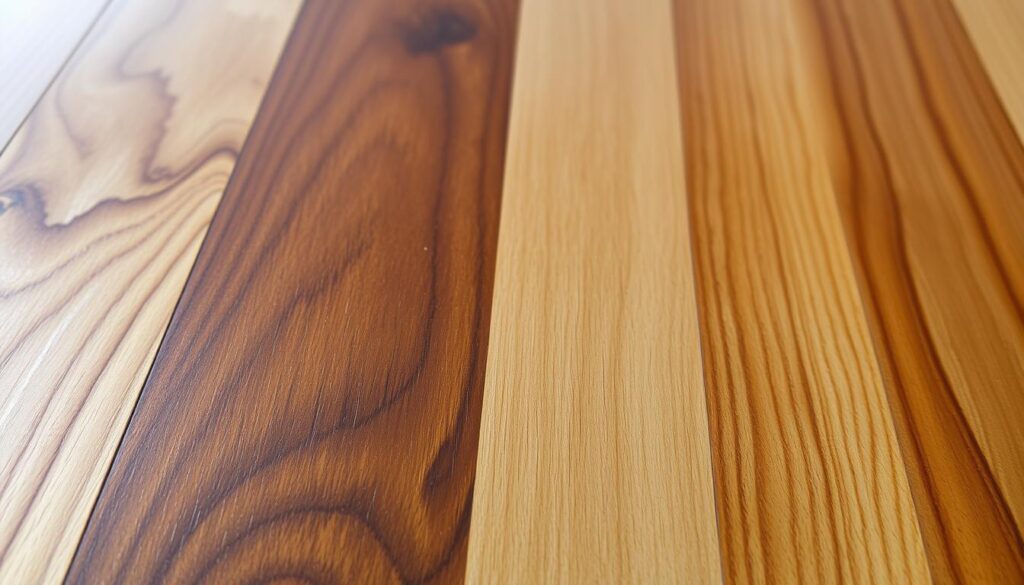
Using these specialty techniques lets me express my creativity. It also makes my projects more valuable and appealing. Whether it’s glazing for depth or using chalk paint for texture, the freedom to innovate is rewarding.
Troubleshooting Common Finishing Issues
Woodworkers often face challenges to get that perfect finish. We’ll tackle common wood finishing problems and offer solutions to fix them.
Dealing with Brush Marks
Brush marks happen when the finish isn’t thinned enough. This leaves lines on the wood’s surface. To solve this, lightly sand the surface to reduce marks. Then, apply a thinner coat with the right technique for a smooth finish.
Fixing Streaks and Runs
Solving Color Inconsistencies
Color issues in wood staining are common. They can be due to poor application or residues like glue18. Use a wood conditioner before staining or choose a new stain carefully. This helps achieve even color.
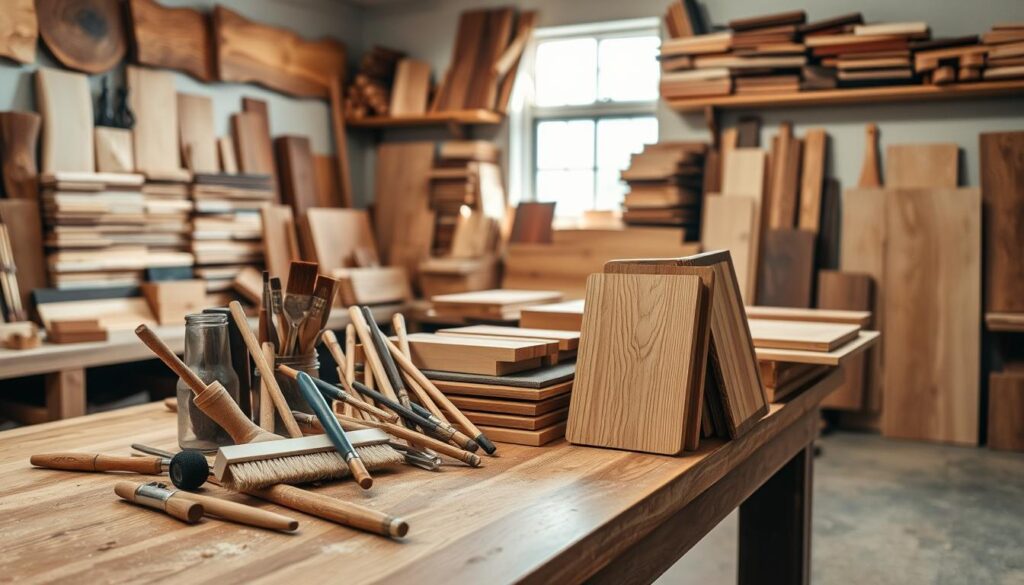
For common issues, focus on Wood Finishing Techniques and Wood Varnishing Tips. Understanding Wood Staining Corrections is key. A steady hand, proper preparation, and knowing how finishes react in different conditions are crucial for a flawless finish.
Eco-Friendly Finishing Options
In today’s world, more people want sustainable wood finishing options. They see how their choices affect health and the environment. Eco-friendly wood protectants keep wood looking good and make homes healthier. We’ll look at eco-friendly wood finishing options that are good for the planet and effective.
Non-Toxic Finishes
Non-toxic wood finishes are key for clean air and less harm to the environment. Unlike old finishes that release harmful chemicals, new options like water-based polyurethanes and natural oils are better. They don’t lose out on looks or durability.
Water-based polyurethanes, for example, have very low chemical emissions. This makes them great for projects that care about the environment19. These finishes are especially important in places where air quality matters a lot.
Natural Oils and Waxes
Natural oils like linseed, walnut, and tung oil are good for the planet. They’re biodegradable and have been used for a long time20. These oils are easy to apply and give wood a beautiful finish.
Natural waxes like beeswax and carnauba wax also make wood look great. They don’t release harmful chemicals into the air20. This shows a growing trend towards safe products that still look and feel great.
Sustainable Practices
Choosing eco-friendly wood protectants is more than just one healthy choice. It’s part of a bigger effort towards sustainability. Every step, from making to applying, helps reduce our carbon footprint. This makes a big difference in keeping our planet safe for the future.
>>Get 16,000 Woodworking Plans
Tools and Equipment for Finishing
To get a perfect wood finish, you need the right tools. Whether you’re experienced or new, knowing your equipment and keeping it in top shape is key.
Brushes, Rollers, and Sprayers
Brushes, rollers, and sprayers are great for different finishes. High-quality brushes apply smoothly without bristles falling off. Rollers cover big areas fast. Sprayers give a fine, even coat for a pro look.
Different saws and drills, like chop saws and drill presses, are important for wood prep. They affect the finish quality21.
Safety Gear Essentials
Don’t forget the importance of safety gear in wood finishing. Wear gloves, goggles, and respirators to protect against harmful chemicals and dust. Without them, you could face serious health problems.
Cleaning and Maintenance of Tools
Keeping your finishing equipment in good shape is crucial. Clean brushes, unclog sprayers, and store rollers properly. This keeps them ready for your next project.
Clean tools right after use to prevent residue buildup. Specialized tools like the Festool sander and vacuum are big investments. Proper maintenance is essential22.
| Tool | Usage | Average Cost |
|---|---|---|
| Festool Sander | For smooth sanding of wood surfaces | $500 |
| Festool Vacuum | To clean up wood dust efficiently | $700 |
| Klingspor Sandpaper | Budget-friendly option for effective sanding | Less than half the cost of Festool paper |
Maintaining Finished Wood Surfaces
It’s important to dust them gently with a soft cloth. They also need protection from moisture and sunlight242253. To keep them looking great, use a high-quality furniture wax or polish every few months253
>>Get 16,000 Woodworking Plans
Regular Cleaning Practices
When to Refinish
FAQ
What is Wood Finishing?
Wood finishing is the process of adding a protective layer to wood. This makes the wood look better and protects it from damage. It includes steps like staining, sealing, varnishing, and polishing.
Why is Proper Finishing Important?
Proper finishing is key because it makes wood look good and protects it. It helps wood last longer by keeping it safe from scratches and spills. It also guards against damage from changes in the weather.
What are Common Misconceptions about Wood Finishing?
Many think wood finishing is just about looks. But, the finish you choose affects both how the wood looks and how long it lasts. People also think all finishes are the same, but they’re not. Each one offers different protection and looks.
What are the Differences Between Oil-Based and Water-Based Finishes?
Oil-based finishes give wood a warm look and are very durable. Water-based finishes are clearer and don’t change the wood’s color much. They dry fast and are safer to use. Choosing between them depends on what you want the wood to look like and the project’s needs.
What is the Role of Shellac and Lacquer in Finishing?
Shellac adds a warm glow to wood and is easy to apply. But, it might not last as long as other finishes. Lacquer, on the other hand, creates a glossy, tough finish that dries quickly. Both finishes have their own benefits.
How Important is Sanding When Preparing Wood for Finishing?
Sanding is very important. It makes the wood smooth, removes old finish and imperfections, and helps stains and finishes go on evenly. Using finer sandpaper gives a better finish.
Should Wood Be Cleaned Before Applying a Finish?
Yes, cleaning the wood is crucial. It removes dust, dirt, and oils that can stop stains and finishes from sticking well. Cleaning well ensures a smooth application and a better finish.
How Does Moisture Affect Wood Finishing?
Moisture can stop finishes from sticking and cause problems like blushing. Blushing is when moisture gets trapped under the finish, making it cloudy. Make sure the wood is dry before starting the finishing process.
What Should I Consider When Applying the First Coat?
When applying the first coat, make sure it’s even and don’t apply too much. Too much can cause drips and an uneven finish. This first layer sets the stage for the rest.
How Long Should I Wait Between Finish Coats?
Wait until the previous layer is dry before adding the next. This can take a few hours to overnight, depending on the product. Rushing can make the finish sticky and may need extra work to fix.
How Do I Choose the Right Stain for My Wood Project?
Choosing the right stain involves considering the wood type, desired color, and how the wood reacts to stain. Some woods, like pine or maple, might need a conditioner first for even stain application.
What are the Best Methods for Stain Application?
You can apply stain with a brush for precision or a rag for a softer look. The choice depends on the project’s complexity and the look you want.
How Do I Handle Blending Stains and Performing Touch-Ups?
Blending stains creates custom colors. Make sure to work with compatible products and test on a scrap first. For touch-ups, use a small tool and matching stain to fix any mistakes.
What is the Purpose of Polyurethanes and Varnishes?
Polyurethanes and varnishes protect wood from scratches, moisture, and wear. Polyurethanes offer a durable surface in various sheens. Varnishes enhance the wood’s grain and color but might yellow over time.
How Do I Decide Which Top Coat to Use on My Wood?
Choose a top coat based on the wood’s wear, desired sheen, and overall look. Each top coat has its own benefits for your project.
What Special Technique Can Add Depth to Wood?
Glazing adds depth and definition to wood by applying a transparent or semi-transparent layer over a base stain.
How Can I Give Wood a Time-Worn Look?
Use distressing techniques like beating the wood with chains or sandpaper to create wear spots. Applying an antique glaze can also give wood a vintage look.
What is Chalk Paint and How is it Used?
Chalk paint gives a matte finish and can create a textured, aged look. It’s great for furniture and can be applied without a lot of sanding.
How Do I Deal with Brush Marks When Finishing?
Brush marks can be reduced by using a high-quality brush and applying thin coats. Keep the brush wet to avoid marks. If marks happen, sand them out gently before adding more finish.
How Can I Fix Streaks and Runs in My Finish?
Fix streaks and runs by sanding the area with fine-grit sandpaper and then reapplying the finish. Applying thin coats helps prevent these issues.
What Should I Do if There are Color Inconsistencies in My Finish?
For color inconsistencies, lightly sand the area and apply a new layer of stain or conditioner before staining. This ensures even color absorption.
What are Some Non-Toxic Finishing Options?
Non-toxic finishes include water-based polyurethanes, natural shellac, and certain oils and waxes. These options have lower VOCs, making them safer for users and the environment.
What Safety Gear is Essential for Finishing Wood?
Essential safety gear includes respirators or masks, safety glasses or goggles, and gloves. These protect against fumes, dust, and harmful chemicals.
How Do I Clean and Maintain My Finishing Tools?
Clean tools immediately with the right solvent. Use mineral spirits for oil-based finishes and water for water-based ones. Store them properly to keep them in good shape.
What Should I Do to Maintain My Finished Wood Surfaces?
Maintain wood surfaces by dusting regularly, cleaning with mild soap and water, and avoiding harsh chemicals. Touch-ups and reapplications of top coats may be needed over time.
How Will I Know When It’s Time to Refinish My Wood?
Refinish wood when it shows significant wear like scratches, fading, or when the finish peels or flakes. High-traffic areas may need more frequent refinishing.
Source Links
- The Art and Science of Wood Finishing – https://hardwoodchef.com/blogs/blog/the-art-and-science-of-wood-finishing?srsltid=AfmBOor3yRYN1jS9064YIJD-KkjsK-UnhY289ttT5Y56k5KFFHuyF1w7
- Tips and Tricks for Achieving the Perfect Wood Finish or Stain on Your Furniture | Unfinished Furniture of Wilmington – https://unfinishedfurnitureofwilmington.com/tips-and-tricks-for-achieving-the-perfect-wood-finish-or-stain-on-your-furniture/?srsltid=AfmBOorCeX5y91EPSE0Q5CtEbaMX5Vr-BOoEYVR3vJ0f7VY5mg5ijo1l
- Wood Finishing Techniques for all Types of Wood – https://treeplantation.com/wood-finishing-techniques.html
- UNDERSTANDING WOOD FINISHING – – http://woodtools.nov.ru/books/Understanding_Wood_Finishes.pdf
- Understanding Wood Finishing – https://toolsforworkingwood.com/store/item/AQ-1067.XX
- Understanding Wood Finishing, 3rd Revised Edition – https://www.leevalley.com/en-us/shop/tools/books-and-dvds/112183-understanding-wood-finishing-3rd-revised-edition?srsltid=AfmBOorI7aRRbXPqHAW9UOJVHX1Nbnt_Jp-oqnyr55_T5T-2j-k5DdWr
- The 7 Different Types of Wood Finishes: A Comprehensive Guide – https://www.targetcoatings.com/2023/09/20/types-of-wood-finishes/
- Wood Finishing Tips – https://www.familyhandyman.com/list/wood-finishing-tips/?srsltid=AfmBOooqgnPS37c-R6BaVF_3xSY0cz_7OyHqvIHGnM9E2sarxEJVZKyQ
- How to Prep Wood For Stain: Sanding, Cleaning & Color Selection | General Finishes – https://generalfinishes.com/instructions/how-prepare-wood-for-stain
- Wood Finishing Tips – https://www.familyhandyman.com/list/wood-finishing-tips/?srsltid=AfmBOorgLtdJJEYTxtUYvthAh_fuA_KMZPg6fkrW7suejokzNGY2plmh
- How to Finish Wood: 15 Steps (with Pictures) – wikiHow – https://www.wikihow.com/Finish-Wood
- The Best Tips on How To Stain Wood – HB ELEMENTS Elements – https://www.hardieboysinc.com/the-best-tips-on-how-to-stain-wood/
- Tips for Staining Wood The Pros Way – Real Milk Paint – https://www.realmilkpaint.com/blog/tips/tips-for-staining-wood-from-realmilkpaint-com/?srsltid=AfmBOorRmN3lCRpRBeJp2N9L8UrBu7gZ2vwcVovXQXHx6So7_p77FrcJ
- 5 Unique Wood Finishing Techniques | KRay Custom Refinish – https://kraycustomrefinish.com/wood-finishing-techniques/?srsltid=AfmBOoplvpARgzy1Or59bW5WNEqVuXung9eNGs5eXebO7rUOs8ZexNUL
- Types of Wood Finishes – https://www.homedepot.com/c/ab/types-of-wood-finishes/9ba683603be9fa5395fab90c31963a4
- 12 Most Effective Wood Sealers According To Experts – https://usvintagewood.com/wood-sealer/
- How To Fix Wood Finishing Problems The Right Way – https://www.realmilkpaint.com/blog/tips/wood-finishing-problems/?srsltid=AfmBOooIttOb2oGRn96vVThxzhOMO_Na1nflmMmAhoR6zD7iAZY-oo0i
- Troubleshooting Finish Application Problems | Popular Woodworking – https://www.popularwoodworking.com/finishing/troubleshooting-finish-application-problems/
- Skill Builder: What Wood Finishes Are The Most Eco Friendly? – https://makezine.com/article/workshop/woodworking/skill-builder-what-wood-finishes-are-the-most-eco-friendly/
- Eco-Friendly Wood Finishing Techniques — The Wood Doctor – https://www.thewooddoctor.com/the-wood-doctor-blog/2024/1/18/eco-friendly-wood-finishing-techniques
- 11 Basic Woodworking Techniques + 7 Tips | The Crucible – https://www.thecrucible.org/guides/woodworking/techniques-tips/
- Perfect Wood Finish, in a Dusty Shop — Blacktail Studio – https://www.blacktailstudio.com/blog/how-to-get-a-perfect-finish-in-a-dusty-shop
- Wood Furniture Finishes & Finishing Techniques – https://waynetowle.com/wood-finishing-process
- Wood Finishing Techniques: Enhancing the Natural Beauty – https://wood-2art.com/blogs/news/enhance-the-natural-beauty-of-woodworking-projects?srsltid=AfmBOopajW1i18iaPiFjXiAtgZItmoHK6cfpm_07cqc_MkKzTmjmjR2N
- The Art and Science of Wood Finishing – https://hardwoodchef.com/blogs/blog/the-art-and-science-of-wood-finishing?srsltid=AfmBOop8LfTufm-VCY09bKPizS_Fi6ChLtNwyTSdW0DJ8cV44bN62Or6

